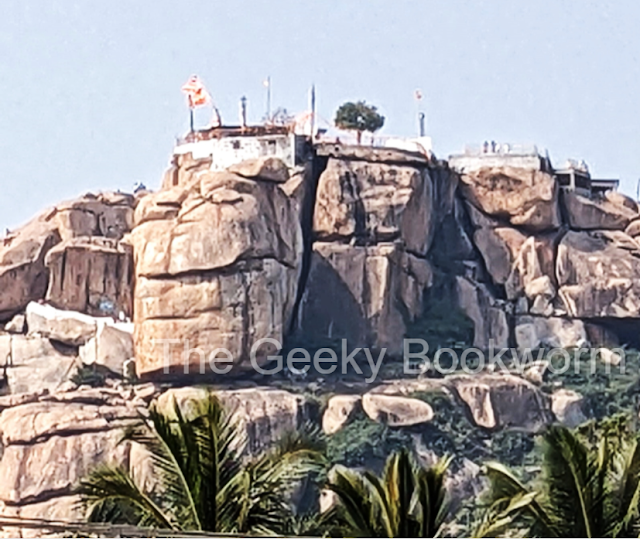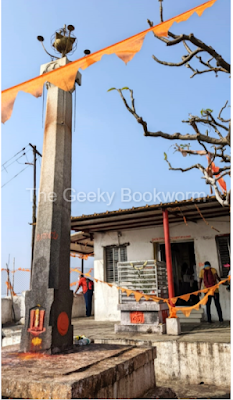Hampi: The remains of the Vanara Kingdom
In the last part of the Hampi series, we dwell further into the past; from the Medieval Kingdom of Vijayanagara to the ancient Vanara(Moneky) kingdom of Kishkindha. Located at a distance of 30km from the buzzing city centre of Hampi, lies the rocky mountains of Annegudi. As soon as one enters this region, one is mesmerized by the cliffs overlooking the gentle Tungabhadra River.
 |
| The panoramic view of Hampi (PC: Rajni) |
After driving through the rich fertile land, we reached the primary mountain of Kishkindha. Lord Hanuman(the Monkey God) was born here in the Treta Yug.
 |
| At the foothills of the Kishkindha cliff |
The climb involving 600 steps, to the top of the mountain, was steep and arduous. Devotees are expected to make this journey barefoot. A part of the mountain naturally resembles the shape of Hanuman’s face.
 |
| Cliff cut like Lord Hanuman's face |
As one reaches the top, one is spellbound by the spectacular
view! You get to witness the panoramic view of Hampi which includes the Royal
enclosure, temples, mountainous peaks and the river. It truly is breathtaking! Moreover,
there is an ancient temple and a Havan Kund (fire pit for offerings). It is the
spot where Mother Anjani is said to have meditated for years as a result of
which, she was blessed with Hanuman.
 |
| Shabari Ashram under redevelopment |
Shabari Ashram, near Pampa Sarovar, is just a few meters
away from the Kishkindha hill. According to popular legend, this quaint little
ashram was the place where Shabari, a devotee gave Lord Ram and Lakshman the
Jujube (ber) fruit. The beautiful ashram leads to a cave.
 |
| Havan Kund at Kishkindha Cliff |
At two opposite ends of Hampi lie the Sugriv and Vali caves. They were brothers and Vanara chieftains. The Vali cave lies on a hillock and at its foothills is a temple complex dedicated to Goddess Durga. A narrow path from the premise of the temple leads to Vali’s fort.
 |
| The rocky pathway to the top of the cliff |
One has to traverse over
huge boulders to enter the regal gate of the Kingdom. This small land on the hill,
which was once the home of the Vanaras has a deep well, lots of fruit trees and
fresh grass for the cows to graze.
 |
| Vali's cave entrance |
Annegudi and Hampi are filled with a large number of monkeys. If you are planning a visit to the UNESCO world heritage site, make sure to carry food and water bottles in a bag. Otherwise, the monkeys will snatch them away. My trip to Hampi was very short. Hence, I missed visiting Sugriv’s cave and trekking to other nearby peaks. There are a lot of temples and monuments that I haven’t included in my blog.
 |
| The temple on the hillock |
These are Kadlaikalu Ganesha,
Mustard Ganesha, Krishna temple and Bazaar, Saraswati temple, Ugra Narasimha,
Badavi Linga and many more. As I mentioned before, there are 3000 temples in
Hampi and it takes a year to completely explore this land.
I came to Hampi with stories of Krishna Deva Raya and Tenali
Rama. But I have returned enriched with historical knowledge about the evolution
of Hampi. From Kishkindha to Vijayanagara, Hampi is a bountiful treasure for
history buffs. And one mustn’t miss it!
Do read Part I and Part II of the Hampi series
Hope you enjoyed reading this series!





This is so informative and interesting!
ReplyDeleteI am so glad you enjoyed reading it!
Delete